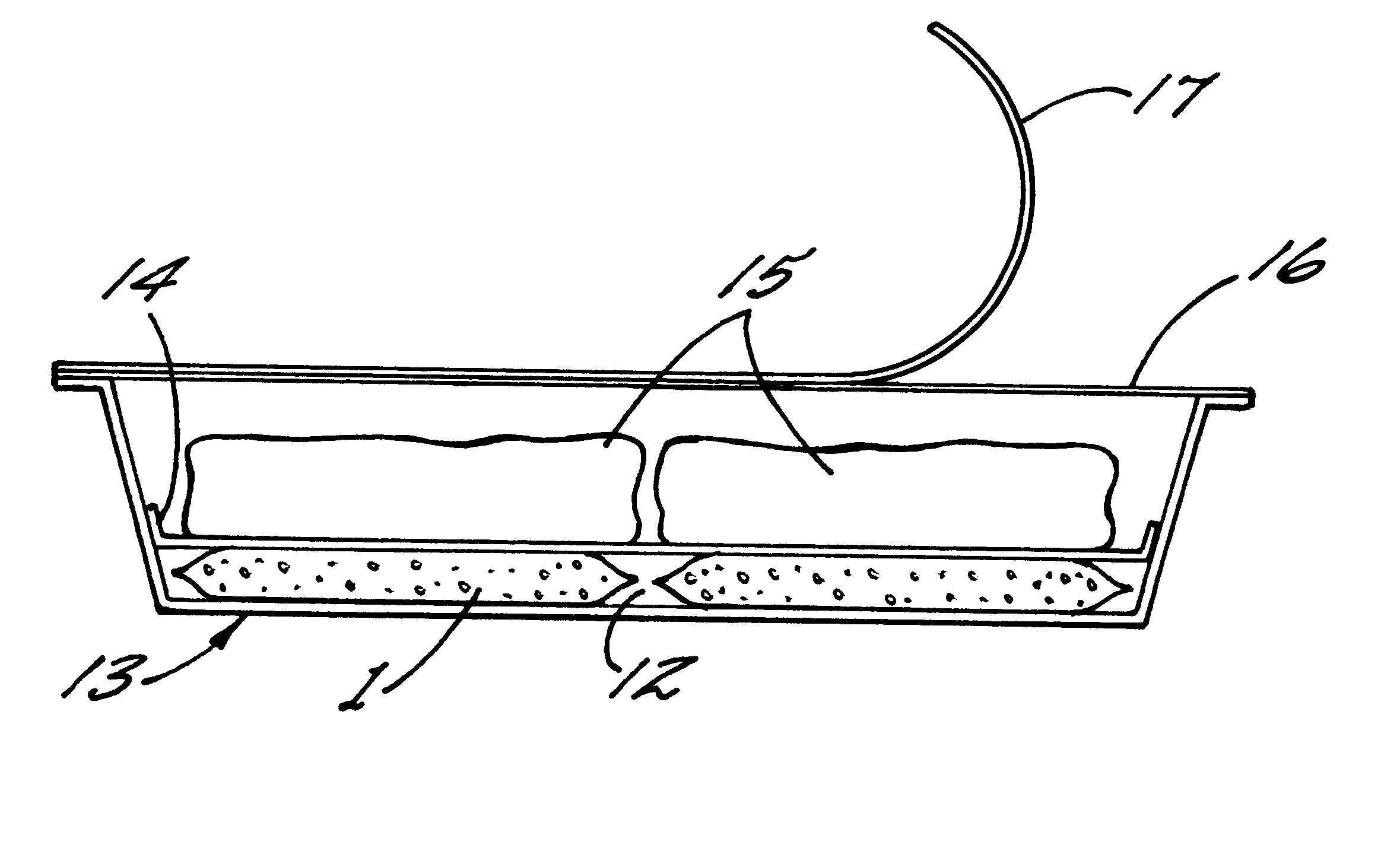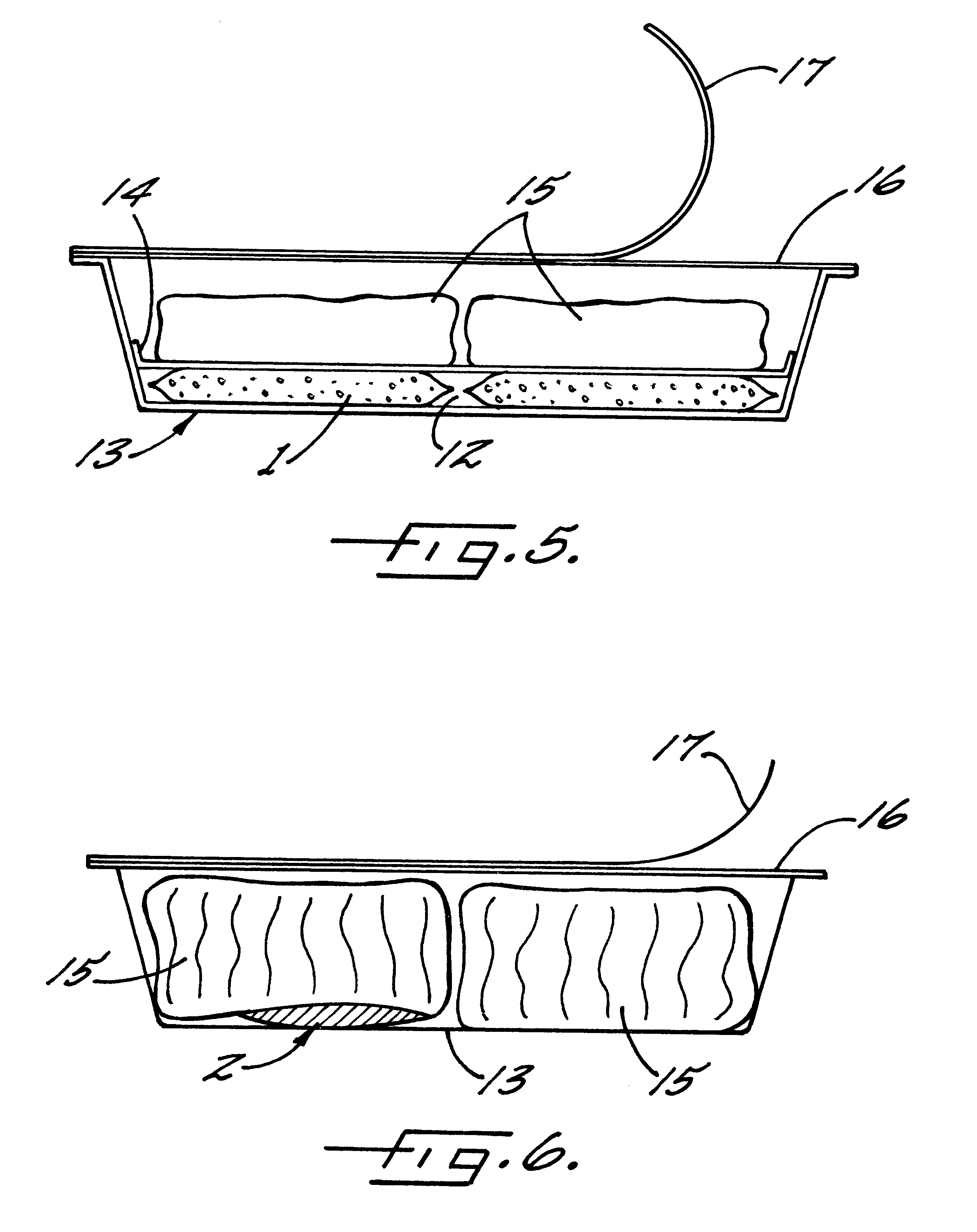Packaging for meat and foodstuff
a technology for meat and foodstuffs, applied in the field of meat and foodstuffs packaging, can solve the problems of generalized inconvenient vacuum packaging for retail display, browning of meat but subsequent spoilage, and browning of mea
- Summary
- Abstract
- Description
- Claims
- Application Information
AI Technical Summary
Benefits of technology
Problems solved by technology
Method used
Image
Examples
examples 1
In a preferred embodiment of the present invention the carbon dioxide evolving system comprises a solid acidic substance in combination with a substance reacting with said acid to release carbon dioxide. Typically the substance is a carbonate or hydrogen carbonate compound. Various mixtures of carbonates and / or hydrogen carbonates may be combined in various embodiments.
Typically, to prevent initiation of the carbon dioxide evolution process once the acid and carbonate (etc.) are mixed, all components should be solid. Accordingly, in many cases the acidic compound used will comprise an organic acid though other acidic compounds able to react with the carbonate (etc.) to release carbon dioxide are known and may be used.
In a preferred embodiment the carbon dioxide evolving system comprises citric acid in combination with sodium hydrogen carbonate. Each of these, providing they are of sufficient purity, are commonly used food additives and may be safely used in various emb...
examples 2
Oxygen Removal
A range of chemical and physical systems which can absorb, adsorb or otherwise remove oxygen are known. Each of these may be used in various embodiments of the present invention. Typically, for simplicity, the substances associated with the removal of oxygen from within the package will be combined with the carbon dioxide evolving substances. This requires some compatibility between the components and generally the simpler chemical or physical systems will be preferred.
In a preferred embodiment the oxygen removal system relies upon ascorbic acid whose oxidisation by free oxygen in the package is catalysed by a small amount of iron compounds. The combination of such components with the citric acid / hydrogen carbonate system described under Example 1 appears compatible in tests to date. In a further preferred embodiment, sodium carbonate or bicarbonate and citric acid are combined with finely divided iron.
Other compounds and systems able to remove oxygen from a package ar...
examples 3
Sample Calculations
Take a thermoformed tray of thickness 500 microns and dimensions 25.times.10.times.5 cm.
Volume of tray is 1250 cc.
Surface area of tray is 0.06 m.sup.2.
If the tray is made from PVC, a typical Carbon dioxide transmission rate is 500 cc per m.sup.2 over 24 hours per 25 micron i.e. 500 / 20 per m.sup.2 over 24 hours i.e. 25 cc per m.sup.2 in 24 hours.
The surface area of the tray is 0.06 m.sup.2 so we would expect to lose 1.5 cc per day.
At 0.degree. C. permeation rate is reduced by a factor of approximately 4.2, therefore we would expect to lose 0.36 cc per day through the tray.
Over the lifetime of the package i.e 10 weeks, the Carbon dioxide loss through the tray would be 25 cc.
The oxygen transmission rate of the PVC would be 150 cc per m.sup.2 over 24 hours per 25 micron, therefore the amount of oxygen entering the pack through the tray would be 7.5 cc over ten weeks.
Typical transmission rates through the peelable barrier are as follows:
Carbon dioxide-25 cc per m.sup.2...
PUM
 Login to View More
Login to View More Abstract
Description
Claims
Application Information
 Login to View More
Login to View More - R&D
- Intellectual Property
- Life Sciences
- Materials
- Tech Scout
- Unparalleled Data Quality
- Higher Quality Content
- 60% Fewer Hallucinations
Browse by: Latest US Patents, China's latest patents, Technical Efficacy Thesaurus, Application Domain, Technology Topic, Popular Technical Reports.
© 2025 PatSnap. All rights reserved.Legal|Privacy policy|Modern Slavery Act Transparency Statement|Sitemap|About US| Contact US: help@patsnap.com



